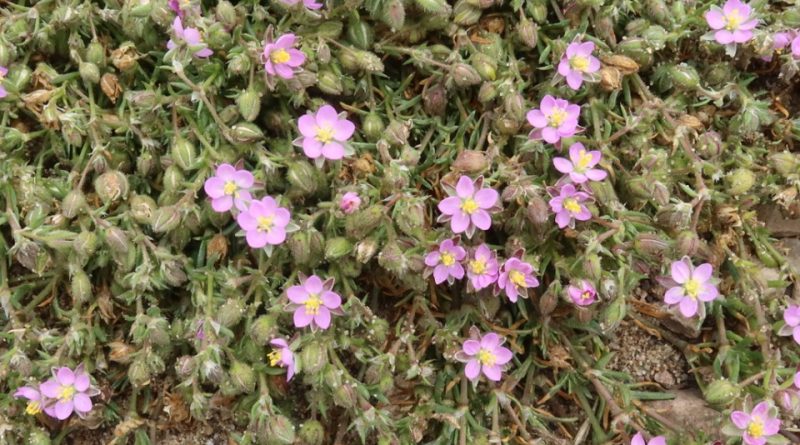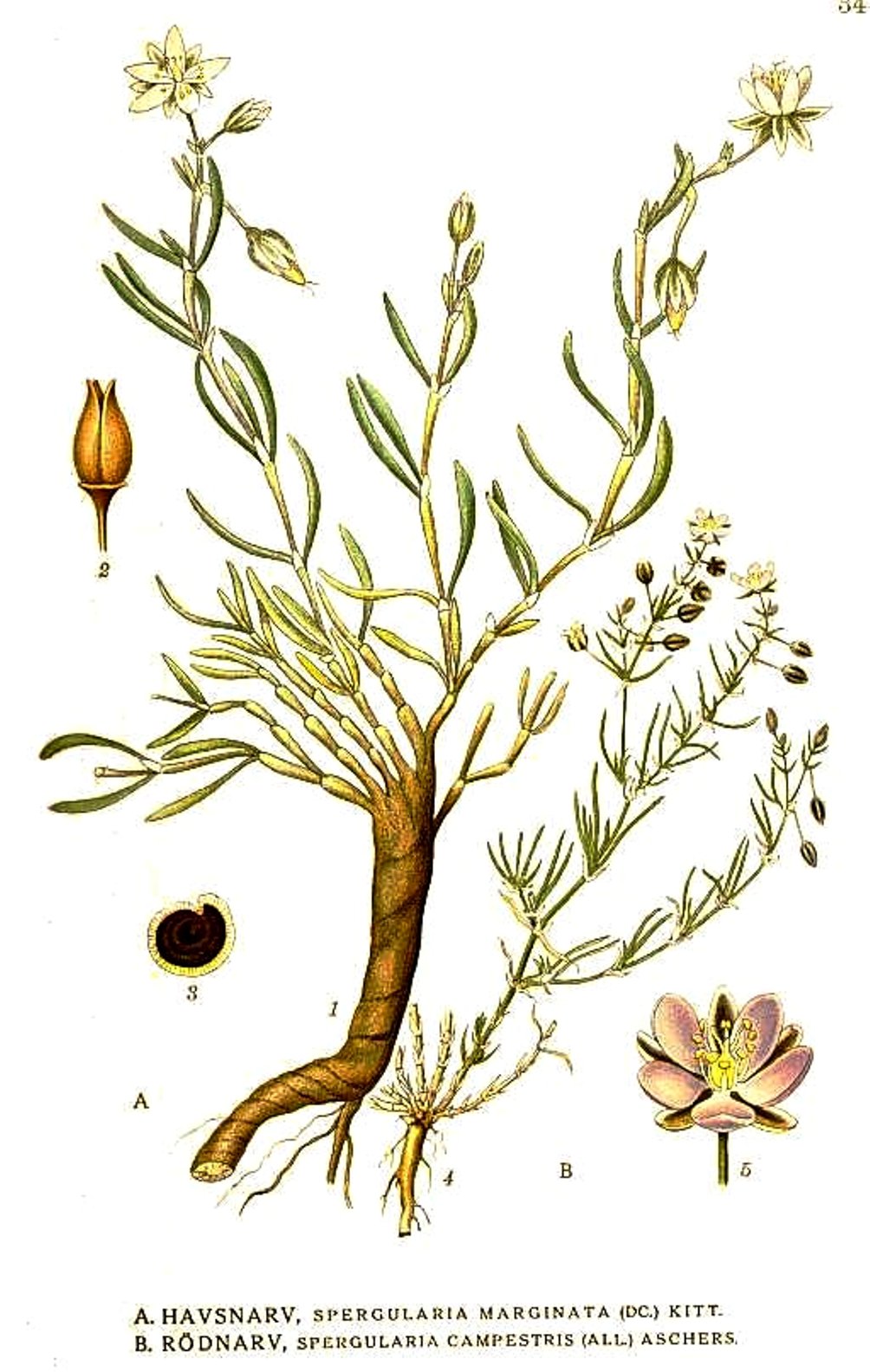Spergularia rubra
Spergularia rubra
The Red sandspurry (Spergularia rubra (L.) J. Presl & C. Presl) is a herbaceous species belonging to the Caryophyllaceae family.
Systematics –
From a systematic point of view it belongs to:
Eukaryota Domain,
Kingdom Plantae,
Subarign Tracheobionta,
Magnoliophyta Division,
Magnoliopsida class,
Subclass Caryophyllidae,
Order Caryophyllales,
Caryophyllaceae family,
Genus Spergularia,
S. rubra species.
Basionimo is the term:
– Arenaria rubra L ..
The terms are synonymous:
– Alsine alpina Willk.;
– Alsine radicans Guss.;
– Alsine rubra (L.) Crantz;
– Arenaria campestris (L.) All.;
– Arenaria campestris L.;
– Arenaria membranacea Gaterau;
– Arenaria radicans (C.Presl) Spreng.;
– Arenaria rubra var. campestris L.;
– Arenaria rubra var. canadensis Eaton;
– Buda borealis S.Watson;
– Buda campestris (L.) Kuntze;
– Buda rubra (L.) Desv.;
– Buda rubra (L.) Dumort.;
– Corion rubrum (L.) N.E.Br.;
– Fasciculus ruber (L.) Dulac;
– Lepigonum anceps Bartl.;
– Lepigonum brevifolium Bartl.;
– Lepigonum brevifolium var. anceps (Bartl.) Kindb.;
– Lepigonum brevifolium var. laxiflorum (Bartl.) Kindb.;
– Lepigonum largiflorum F.Muell.;
– Lepigonum largiflorum F.Muell. ex Kindb.;
– Lepigonum laxiflorum Bartl.;
– Lepigonum radicans Kindb.;
– Lepigonum rubrum (L.) Wahlb.;
– Lepigonum rubrum var. perennans Kindb.;
– Lepigonum sperguloides Fisch. & C.A.Mey.;
– Melargyra rosea Raf.;
– Melargyra rubra (L.) Raf.;
– Spergula marina Dufour;
– Spergula marina Dufour ex Steud.;
– Spergula radicans D.Dietr.;
– Spergula rubra (L.) Bartl.;
– Spergula rubra (L.) D.Dietr.;
– Spergula rubra subsp. campestris (L.) Maire;
– Spergula rubra subsp. radicans (J.Presl & C.Presl) O.Schwarz, 1949;
– Spergularia alpina Willk.;
– Spergularia amurensis Pomel;
– Spergularia anceps Walp.;
– Spergularia arenosa Foucaud;
– Spergularia arenosa Foucaud ex Merino;
– Spergularia borealis (S.Watson) B.L.Rob.;
– Spergularia borealis Rob.;
– Spergularia brevifolia Walp.;
– Spergularia campestris (L.) Asch.;
– Spergularia campestris f. pubescens Hauman;
– Spergularia campestris var. alpina (Boiss.) Gürke, 1899;
– Spergularia campestris var. radicans (C.Presl) Gürke, 1899;
– Spergularia catalaunica P.Monnier;
– Spergularia diandra Coss.;
– Spergularia diandra Coss. ex Willk. & Lange;
– Spergularia laxiflorum Walp.;
– Spergularia longipes Nyman;
– Spergularia lycia Monnier & Quézel;
– Spergularia polyphylla Rohrb.;
– Spergularia radicans C.Presl;
– Spergularia radicans J.Presl;
– Spergularia rubra subsp. alpina (Willk.) Losa & Rivas Goday;
– Spergularia rubra subsp. campestris (L.) Rouy & Foucaud;
– Spergularia rubra subsp. campestris (L.) Čelak., 1881;
– Spergularia rubra subsp. radicans (J.Presl & C.Presl) Nyman, 1878;
– Spergularia rubra var. amurensis (Pomel) Batt.;
– Spergularia rubra var. campestris (L.) Fenzl, 1843;
– Spergularia rubra var. campestris (Willk.) Batt.;
– Spergularia rubra var. campestris A.Gray;
– Spergularia rubra var. elongata (Fenzl) Hook.f.;
– Spergularia rubra var. longipes Lange, 1874;
– Spergularia rubra var. perennans B.L.Rob.;
– Spergularia rubra var. stipularis Boiss., 1867;
– Spergularia rupestris Fenzl;;
– Spergularia rupestris var. elongata Fenzl;
– Spergularia sperguloides Hausskn.;
– Stipularia rubra (L.) Haw.;
– Tissa rubra (L.) Brandegee;
– Tissa rubra (L.) Britton;
– Tissa rubra var. perennans (Kindb.) Greene.
Etymology –
The term Spergularia is similar to the genus Spergula (from spargeo to scatter, to diffuse: due to the ability of plants of this genus to produce numerous small seeds that are easily dispersed) and with the same etymology.
The specific rubra epithet comes from rúbeo rossendere, to be red: due to the presence of characteristic reddish elements.
Geographic Distribution and Habitat –
The Red sandspurry is a species native to Europe, Asia and North Africa, and is present in other continents, including North and South America and Australia, as an introduced species and in many areas a common weed, for which today has become subcosmopolitan in temperate areas.
In Italy it is present in all regions.
Its habitat is that of disturbed environments, in uncultivated fields, along beaten paths, on sandy and arid soils, from sea level to the lower mountain belt, rarely even higher.
Description –
Spergularia rubra is an annual or perennial herbaceous plant that produces a slender, glandular stem up to about 25 centimeters long.
This is lined with slightly fleshy linear or filiform leaves, each less than 2 centimeters long. The leaves may be pointed with hard spikes or thorns and are accompanied by glossy white lanceolate stipules.
The flowers are found at the axil of the leaves and at the tips of the stems. They have hairy, glandular sepals and five oval round pink petals.
The flowering period is from March to August depending on the latitude and altitude where it grows.
Cultivation –
Spergularia rubra is an annual or perennial plant that is harvested in nature for local use as food and medicinal use.
It is a plant that frequently grows in pavement crevices and other marginal areas of gardens.
It is a calcifuge plant, therefore it needs soils with a neutral to acid pH.
Propagation occurs by seed. Sowing must be carried out in spring or even in autumn directly on site. If sown in autumn, some seeds germinate immediately, others in spring.
Customs and Traditions –
Spergularia rubra is a plant that is used for both edible and medicinal fimi.
In food use, cooked seeds are used. These are dried and ground into flour and used like normal flour to make bread, etc.
In the past it was used mainly in times of famine.
In medicinal use, the plant has diuretic and lithotripic properties.
The plant contains a resinous aromatic substance which is probably the active ingredient.
According to some local traditions it is believed that an infusion relaxes the muscular walls of the urinary tubules and therefore is used in the treatment of kidney stones, acute and chronic cystitis and bladder mucus.
No other uses or uses are known.
Preparation Method –
Spergularia rubra is one of those plants used in the past and today practically no longer used.
In food use, cooked seeds were used, which after being dried and ground were transformed into flour to prepare bread and other products.
In medicinal use, infusions are prepared. The whole plant or even just the flowers is used.
Guido Bissanti
Sources
– Acta Plantarum – Flora of the Italian Regions.
– Wikipedia, the free encyclopedia.
– Useful Tropical Plants Database.
– Conti F., Abbate G., Alessandrini A., Blasi C. (ed.), 2005. An annotated checklist of the Italian vascular flora, Palombi Editore.
– Pignatti S., 1982. Flora of Italy, Edagricole, Bologna.
– Treben M., 2000. Health from the Lord’s Pharmacy, Advice and experiences with medicinal herbs, Ennsthaler Editore.
Photo source:
– https://inaturalist-open-data.s3.amazonaws.com/photos/198284741/original.jpeg
Warning: Pharmaceutical applications and alimurgical uses are indicated for informational purposes only, they do not represent in any way a medical prescription; therefore no responsibility is taken for their use for curative, aesthetic or food purposes.


